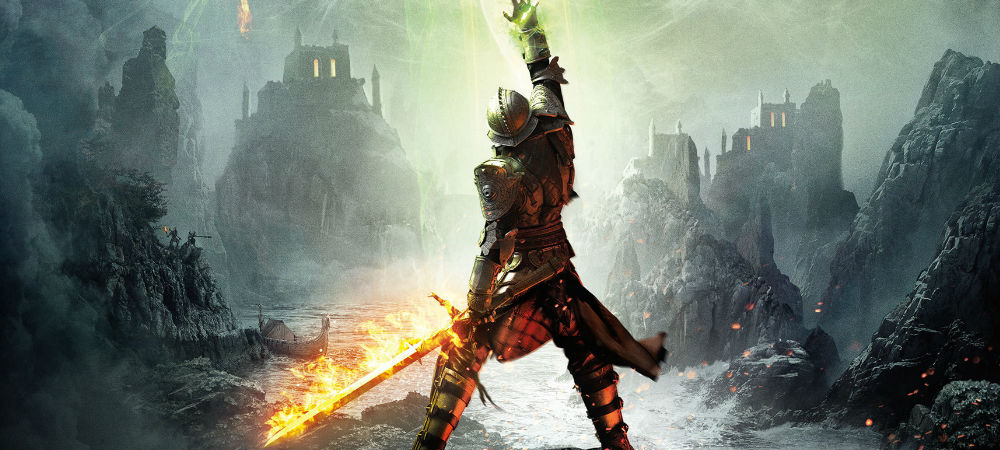This is coming from a big supporter of Origins
I wasn’t very happy with Dragon Age II.
Whereas Origins was a glorious return to old-school RPG sensibilities, Dragon Age II played like an action game that took place in the same universe. I liked the sequel for different reasons, but it felt like a wasted opportunity as it attempted to juggle some of the RPG elements from Origins while having some faults of its own, like re-used environments and a lack of scale.
If you felt the same way, Inquisition may be for you.
Dragon Age: Inquisition (PC [previewed], PS3, PS4, Xbox 360, Xbox One)
Developer: BioWare
Publisher: Electronic Arts
Released: November 18, 2014
MSRP: $59.99
I got a chance to play Dragon Age: Inquisition extensively with multiple classes, and one of the areas I encountered was “The Bog” — the subject of the gamescom demo. During this portion, I played as a Qunari warrior, who happened to be taking advantage of the two-handed skill tree. One of the first things I noticed is that attacks actually had weight to them in Inquisition, as opposed to the floaty feel of Dragon Age II. As executive producer Mark Darrah told me, “faster and easier [combat] got us in trouble in Dragon Age II, so we’re moving away from that.”
The two-handed skillset in Inquisition is ferocious, consisting of abilities like a running charge attack, multiple stuns, and whirlwinds. I was able to answer just about any situation, and close the gap with my dash — but all of the Warrior’s powers felt right within the confines of the class. You can also jump now, which allows you to tactically retreat or gain a better vantage point. There were multiple times where I found a new foothold by way of leaping up to a new location and it felt natural — like the option had always been there.
Of course, the classic tactical camera is back, with all-new improvements in tow for those of you who loved the option in the PC version of Origins. I found myself going back and forth from the satisfying behind-the-back action camera and the tactical view consistently, enjoying both on their own merits. Inside and out, combat has been improved this time around. When asked how much tougher it will be even on normal mode, Darrah responded, “You’ll have more tools at your disposal, and you’ll have to master at least one of them to get by. Whereas in Dragon Age II you could just wing it, Inquisition will challenge players to master something.”
In terms of player choice, BioWare notes that it’s “going back to the personal story that was originally contained in Origins, while opening up the scale.” One of the core faults of Dragon Age II, I felt, was that it had such a small scale and didn’t really do much in terms of advancing a personal story. Speaking to the developers, they stated that Inquisition aims to fix those issues, with four playable races and two genders. BioWare informed me that not only will your race and gender affect how people around the world treat you, but it will also change the core story a bit.
Just as your Origins avatar was the Warden, the new Inquisitor position comes with a lot of responsibility, which ramps up over the course of the game. While your authority may be rather tame towards the start, eventually you’ll be able to pass judgments on others — with the choice to make them an agent of the Inquisition, a prisoner, or even execute them yourself. Even with experimenting on select scenarios throughout my gametime, it seemed clear that the story would have an impact on the rest of the world, which is great news for those of you who crave a more open, epic tale.
The build I played was on PC, and you could really see that new engine working overtime. As the wind blew and the rain fell in The Bog, trees really twisted and flapped in the breeze, adding to the feel of the environment as you hacked your way through hordes of the undead. As a general rule I’m not a big proponent of visuals over gameplay, but it’s nice to know that Inquisition has both bases covered, and has plenty of detail. I was assured again that no areas would be re-used like in Dragon Age II, and everything I saw during my time spent with the demo backed up that claim. BioWare states that the current-generation versions of the game should look roughly the same as the PC build.
I also got a chance to test out the new map icon system, which adds a bit more exploration to the mix. In short, many objectives aren’t exactly spelled out for you with a conveniently-wrapped Google Map-esque tack like in the past. Instead, select quests will give you a giant circular “gist” icon as I call it, letting you know that your quest is somewhere in the area. It’s a nice compromise since the exploration zones are around ten times bigger than any previous zone in the series, so you won’t get completely lost — but you’ll have to at least work for it.
Dragon Age: Inquisition is shaping up to be a glorious return to most of what made Origins so great. The jury is still out on whether or not BioWare can keep that greatness up throughout the course of the entire adventure, but from what I’ve played so far, I’m pretty satisfied, and most of my fears have been quelled. There’s more Inquisition coverage on the way later this month, including a big announcement that I can’t wait to share.


